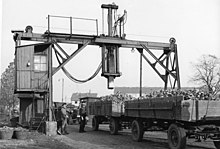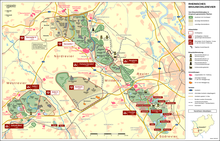Berggeist pit
| Berggeist pit | |||
|---|---|---|---|
| General information about the mine | |||
| Mining technology | Open pit | ||
| Information about the mining company | |||
| Operating company | Lignite and Briquet Factory Berggeist AG | ||
| Start of operation | 1858 | ||
| End of operation | circa 1965 | ||
| Funded raw materials | |||
| Degradation of | Brown coal | ||
| Geographical location | |||
| Coordinates | 50 ° 47 '52.9 " N , 6 ° 52' 47.9" E | ||
|
|||
| Location | Badorf | ||
| local community | Bruehl | ||
| District ( NUTS3 ) | Rhein-Erft district | ||
| country | State of North Rhine-Westphalia | ||
| Country | Germany | ||
| District | Rhenish lignite district | ||
The pit mountain spirit is a former lignite - opencast mining in the Ville southwest of Brühl in the Rhineland . In addition to the actual pit, the operation also included a briquette factory of the same name and a power station . The company has been shut down since the mid-1960s. The Phantasialand amusement park is now located on the former mine site . The mine has been reclaimed , it remained several artificial lakes in opencast mining holes exist; the largest is the Berggeistsee in the pit south-east of federal highway 51 , while the amusement park uses a smaller one.
history
Mine and briquette factory
As early as 1800 there were several smaller "peat pits" (French: Torbieres ) in the area of the later Berggeist mine .
As a result of industrialization, the need for fuel rose sharply from the middle of the 19th century and with it the price of coal, while wood became scarce. This led to the fact that the inferior lignite became competitive with the more expensive hard coal, and several lignite "pits", small open-cast mines , arose in the foothills . One of these was the Berggeist mine on the Schnorrenberg , which received an operating license from the Prussian Mining Authority in 1858 . The mine experienced an upswing when the miners' strike of 1889 caused the prices for coal from the Ruhr to skyrocket. In search of a cheaper alternative, the energy-intensive sugar factory in Brühl , founded in 1883, bought the Berggeist mine. The raw lignite was transported from the mine to the boiler house of the sugar factory in the east of Brühl via an approximately 5 km long material cable car .
In order to be able to operate the pit economically outside of the beet campaign , the sugar factory founded a briquette factory on the edge of the pit in 1893 . The briquette factory produced until 1936.
After the coal mine had been largely exhausted , the Braunkohlen- und Briketwerk Berggeist AG took over other mining concessions in the area to secure the coal supply for the briquette factory : 1910/11 Hedwig mine , 1913/14 Katharinenberg , Müllersgrube , Raymannsgrube and Hältersberg . In 1914/15 Berggeist AG bought the lignite briquette factory Lucretia GmbH in Badorf , whose field was south of Berggeist, to supplement its own briquette factory .
In 1920 the Rheinische Metallwaaren- und Maschinenfabrik (Rheinmetall), for which Berggeist AG was a valuable fuel supplier for its steelworks, took over the majority of the shares. Rheinmetall later sold this to the Bank for Industry and Administration in Berlin. In 1937 the property was taken over by the Kohlensäure-Industrie AG (KIAG) in accordance with the Transformation Act . Another major shareholder was the coal wholesaler S. Baum GmbH from Berlin. In 1966, KIAG, and with it Berggeist AG, was taken over by Preussag .
power plant
On March 15, 1899, after about two years of planning and preparation (concession agreements with municipalities in the Bonn district), the Elektricitätswerk Berggeist Aktiengesellschaft based in Brühl (EWB) was founded by the entrepreneurs F. Flecken and E. Geist. The latter had gained experience with electrical systems as an employee of the Helios Society for Electric Light and Telegraph Construction in Cologne and had previously founded and operated smaller power plants in Treis on the Moselle and in Cologne-Zollstock . In addition to the two entrepreneurs and other Berlin investors, the sponsors were the Gesellschaft für Elektrizitätsgesellschaft AG (Gesfürel) Berlin and the Union Elektrizitätsgesellschaft AG Berlin.
The power plant, which was built in a charred area of the pit, was supplied with fuel directly from the pit, went into trial operation on December 19, 1899 and, from January 6, 1900, supplied electricity with three three- phase generators , initially with 110 V, later with 220 V. Connected the mine itself, the sugar factory, the city of Brühl and gradually 20 surrounding communities. However, it took a few more years before the supply network was further developed.
In 1906, the Rheinisch-Westfälische Elektrizitätswerk (RWE), which was also founded with funds from Gesfürel , took over the majority of shares in EWB and integrated the power plant into the development of its supply network. After the construction of the Goldenberg power plant near Knapsack (completed in 1914), Berggeist was shut down in November 1914 (apart from an emergency operation during World War I ) and finally shut down in 1925 and soon afterwards demolished. The opencast mine disappeared after its final charring after 1939.
In 1934 the EWB company was dissolved. For a long time, RWE maintained a regional supply point under the name Berggeist. (Today the region operates under RheinEnergie ). To this day, RWE maintains an administrative office in the former EWB headquarters.
literature
- Walter Buschmann, Norbert Gilson, Barbara Rinn: Lignite mining in the Rhineland . The architectural and art monuments of North Rhine-Westphalia: Volume 1. Ed .: Landschaftsverband Rheinland and MBV-NRW . Werner, Worms 2008, ISBN 978-3-88462-269-8 .
Individual evidence
- ↑ a b R. Bölkow: How Heimerzheim and Dünstekoven got their electric light . In: Heimatbote 9/2008, Heimat work group, Heimerzheim local committee on www.ak-heimat.de ( page no longer available , search in web archives ) Info: The link was automatically marked as defective. Please check the link according to the instructions and then remove this notice. (PDF; 3.2 MB)
- ↑ Tranchot: Topographical survey of the Rhineland
- ↑ BRÜHL - a lively city introduces itself at www.bruehl-info.de
- ↑ Braunkohlen- und Briketwerk Berggeist AG at www.aktiensammler.de
- ↑ Brown coal and briquette factory Berggeist (sic) on nonvaleur-shop.de
- ^ Walter Buschmann, Norbert Gilson, Barbara Rinn: Brown coal mining in the Rhineland. ed. from LVR and MBV-NRW , 2008, p. 301 ff
- ↑ Buschmann et alii, p. 305




